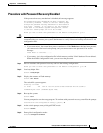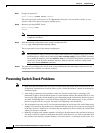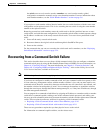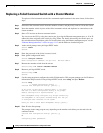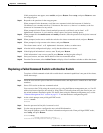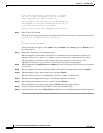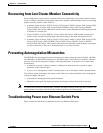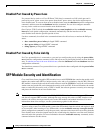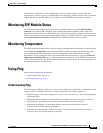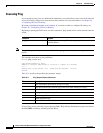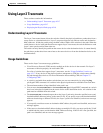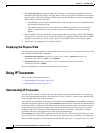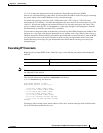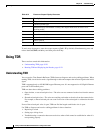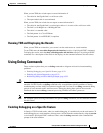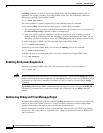
45-15
Catalyst 3750-E and 3560-E Switch Software Configuration Guide
OL-9775-02
Chapter 45 Troubleshooting
Monitoring SFP Module Status
If the module is identified as a Cisco SFP module, but the system is unable to read vendor-data
information to verify its accuracy, an SFP module error message is generated. In this case, you should
remove and re-insert the SFP module. If it continues to fail, the SFP module might be defective.
Monitoring SFP Module Status
You can check the physical or operational status of an SFP module by using the show interfaces
transceiver privileged EXEC command. This command shows the operational status, such as the
temperature and the current for an SFP module on a specific interface and the alarm status. You can also
use the command to check the speed and the duplex settings on an SFP module. For more information,
see the show interfaces transceiver command in the command reference for this release.
Monitoring Temperature
The switch monitors the temperature conditions and uses the temperature information to control the fans.
Use the show env temperature status privileged EXEC command to display the temperature value,
state, and thresholds. The temperature value is the temperature in the switch (not the external
temperature).You can configure only the yellow threshold level (in Celsius) by using the system env
temperature threshold yellow value global configuration command to set the difference between the
yellow and red thresholds. You cannot configure the green or red thresholds. For more information, see
the command reference for this release.
Using Ping
These sections contain this information:
• Understanding Ping, page 45-15
• Executing Ping, page 45-16
Understanding Ping
The switch supports IP ping, which you can use to test connectivity to remote hosts. Ping sends an echo
request packet to an address and waits for a reply. Ping returns one of these responses:
• Normal response—The normal response (hostname is alive) occurs in 1 to 10 seconds, depending
on network traffic.
• Destination does not respond—If the host does not respond, a no-answer message is returned.
• Unknown host—If the host does not exist, an unknown host message is returned.
• Destination unreachable—If the default gateway cannot reach the specified network, a
destination-unreachable message is returned.
• Network or host unreachable—If there is no entry in the route table for the host or network, a
network or host unreachable message is returned.



